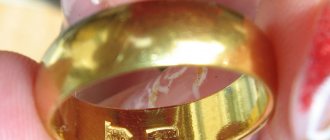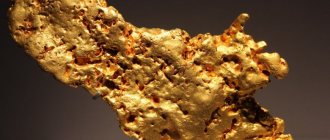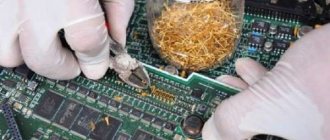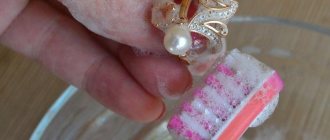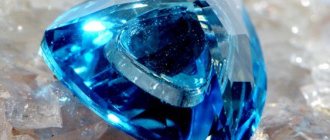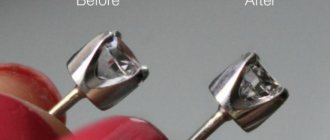Gold refining is a process of purifying the precious metal from impurities, carried out both in an industrial environment and in a home laboratory. In 2014 alone, 12.5 tons of gold were extracted from electronic waste in Russia. As a rule, gold is refined on an industrial scale by electrolytic means, which involves depositing pure metal on a cathode and separating impurities in the form of sludge. This method is good for its low cost and high degree of refining of the resulting product. Such gold will have a purity of at least 999.9%.
However, there are alternative cleaning methods that some craftsmen use at home. These include dry cleaning of scrap with chlorine and wet cleaning with various chemicals. When molten metal is exposed to chlorine, all impurities sublimate, forming chlorides. While silver chloride, on the contrary, rises and covers the gold. As a result, gold is obtained with a purity of 996.5%, and silver - 999.0%. Wet methods are used to purify gold by first dissolving it and accompanying metals in aqua regia, and then successively treating them with various reagents to precipitate them.
Existing gold purification methods
The following methods are used for cleaning:
- Dry metal refining methods involve treating scrap gold with chlorine or potassium nitrate (KNO3). Nitre purification is a method in which the molten raw material is exposed to the open flame of a burner in a heat-resistant ceramic crucible. Saltpeter is constantly added to the melt in small doses until it no longer causes a reaction from impurities. Borax is used to remove impurities of zinc, bismuth and others. Chlorine purification using the Miller method is a method in which impurities are sublimated to form chlorides. It is usually used in industrial enterprises because it is hazardous to health. It is not recommended to use it at home.
- Wet gold purification methods are designed for processing scrap with various inclusions of other metals. They differ depending on what metals are included in its composition. For example, if there is a lot of silver in the alloy, which prevents it from dissolving in aqua regia, then copper can be added. Wet methods include gold leaching using NaCN.
- Chemical methods for extracting metal from laboratory and technical residues. There are known methods for precipitating gold from a chloride solution using sugar, ethyl alcohol, oxalic or formic acid, sulfur dioxide, sodium thiosulfate, etc.
- The reduction method, based on the inertness of gold to the effects of nitric acid, is used to isolate the metal from technical residues. Gold-containing scrap is boiled in acid, then washed, dried and melted. Using this method, you can get from 10 g of scrap of 585% purity to 6.5 g of gold of 900% purity.
- Refining of precious metal from gold chloride solution. Occurs by reduction with iron sulfate. The disadvantage of this method is the introduction of another base metal impurity into the technological process, which increases the consumption of chemical reagents and the amount of by-products.
- Processing of gold-containing grinding powders. The feedstock is immersed in special reactors for dissolving gold, where a mixture of nitric and hydrochloric acids is added in proportions of 1:5 and heated to +90...+100°C. Then the solution is filtered and gold is precipitated with hydrazine hydrochloride, adding copper powder. After which the refined metal is dried, melted and sent for further purification, and the copper slag is shipped to a copper smelter.
- Isolation of precious metal from photographic remains. It is produced by adding Na2CO3, mixing with an alcohol solution of aniline, followed by exposure to light. In this case, the gold completely precipitates.
- Processing of products made from gold-plated non-ferrous metals and alloys.
- Method of gold precipitation using hydrazine hydrochloride.
- Electrolytic refining method.
Gold refining is possible wherever there are raw materials for it. And the starting raw materials can be memory cards of old equipment, parts of radio tubes, buttons, phone batteries, transistors and much more. Let's consider some options for isolating precious metal from used household appliances and several methods that allow you to refining gold using the artisanal method in home laboratories.
List of modern devices with gold
Compared with Soviet technology, modern devices contain much less gold metal. However, there are electronic devices that are in no way inferior in these indicators to technology from the times of the USSR.
For example, the popular HP Laser Jet laser printer contains about a gram of precious metal per composition.
Among the modern devices that are interesting from the point of view of gold mining:
Microcircuits
Solar metal is found in almost all microcircuits. It will be present as gold-plated leads, the number of which is equal to 1/3 of the mass of the microcircuit.
Extracting gold from memory cards
Gold can be obtained from the gold-plated contacts of computer memory cards using hydrochloric acid and hydrogen peroxide, and the same solution can be used several times.
It should be remembered that when performing any actions with chemical reagents, it is imperative to use personal protective equipment and follow safety precautions: carry out all experiments either in the open air or in a fume hood.
First, prepare the source material by cutting off all the gold-plated contacts from the cards with special scissors. Then 500 g of scraps are weighed for etching.
The solution is prepared from a ratio of 4 to 1, that is, take 1 part hydrogen peroxide to 4 parts hydrochloric acid. When peroxide is added to hydrochloric acid, the first decomposes with the release of atomic oxygen. And it, in turn, becomes a catalyst for the reaction of copper with hydrochloric acid and the formation of copper chloride. To avoid partial dissolution of gold, you need to monitor the temperature in the room: it is advisable that it should not be higher than +20...+25°C.
Pour the solution into the cuttings placed in a glass container. 15 minutes after the start of the reaction, the first gold begins to float. After 26 hours, it is separated from the sludge by 90%, and only copper remains on the scrap. All the gilding settles to the bottom of the jar; after a couple of days, the solution can be poured into another container, and then passed through a coffee filter.
The refined gold from the filter is dissolved in aqua regia: to do this, add 60 ml of 36% hydrochloric acid and 3 ml of 65% nitric acid into a gold-plated glass. A violent reaction occurs, as a result of which after 10 minutes all the gold plating dissolves. Now you need to precipitate the gold from the solution. To do this, take sodium pyrosulfite, dilute it with distilled water and pour it into a glass with a metal solution, stirring. In this way, refined gold is deposited at the bottom of the container with the solution. The essence of deposition with pyrosulfite is the release of sulfur dioxide, which, in turn, reduces the metal. Therefore, the reaction occurs with a slight delay.
Now the resulting intermediate product needs to be melted, for which the raw material is placed in a crucible and burned with a burner. To melt metal at home, acetylene, gas welding or propane torches are used. A propane torch does not require an acetylene generator and carbide, therefore it is the most convenient. The resulting ingot of precious metal is weighed on scales: from 500 g of memory card waste, 2.91 g of refined gold can be obtained.
Why is gold refining needed?
The process of purifying gold from impurities is constantly used in jewelry. In the manufacture of high-quality and luxury jewelry, gold of an exceptionally high standard is used. The lower the sample value, the cheaper the product will cost. This will also be reflected in the appearance of the metal, which will be noticed even by a person inexperienced in jewelry making. To independently obtain certain alloys of gold with any metal (to give a shade and, if necessary, change the sample value), the gold must first be thoroughly cleaned of impurities.
Extracting gold from microcircuits
Refining gold from microcircuits is a somewhat more labor-intensive process, since the amount of material unnecessary for the final result in the raw materials (controllers, processors) is much higher here, and it is therefore more difficult to isolate the precious metal.
First you need to get rid of the legs of the microcircuits, since they consist mainly of brass and iron: they are removed with a knife or scissors, leaving only those plated with gold. This is necessary in order to save acid, since reagents are quite expensive today.
Then you need to burn the prepared raw material in an oven, let it cool and crush it with a plastic pestle or rod in a suitable container, possibly metal, given that everything will be covered with ash. The crushed raw material is transferred to a flask, where pure nitric acid is poured to dissolve copper and other metals. Approximately 85% of impurities are removed in this way. The resulting blue solution is filtered. The filtrate containing silver is treated with a concentrated salt solution. As a result, silver chloride precipitates in the form of white flakes, similar to cottage cheese.
The material remaining in the flask must be treated with aqua regia, and this process is best carried out under a hood or through a gas outlet pipe. The resulting green solution containing gold is also filtered and then treated with either sodium pyrosulfite or ferrous sulfate. The powder can be poured directly into the container with the solution, stirring with a glass rod, and then left for several hours so that all the gold precipitates.
Next, the product needs to be filtered, the filter dried and proceeded to firing. Melting of the metal is carried out in a crucible in a muffle furnace. For firing you will need a screwdriver, tweezers, tongs to remove the crucible from the oven, and a metal rod to stir the product. It is also good to prepare a little nitric acid in advance in the flask where the resulting calcination product will be transferred. This is done so that the acid cleans the gold and turns it yellow.
The unnecessary edges of the filter are cut off and placed in a crucible, squeezing and compacting. After this, the crucible is placed in a muffle furnace for 12 - 15 minutes. The resulting product, while still hot, is placed in nitric acid, placed on a stove and boiled for some time until the gold bar is completely cleansed.
There is also refining using tin chloride, pickling using ferric chloride, metal purification using zinc and many other chemical methods.
What does gold look like in stone?
It is quite difficult for an inexperienced prospector to distinguish the precious metal in a stone. Gold is rarely found in its pure form, and numerous alloys vary in color and degree of luster. In addition, some types of stone have a characteristic shine and can easily be confused with precious ore.
For example, sphalerite or, as it is also called, zinc blende. This is a dark (black or dark brown) color stone with a metallic sheen. Unlike gold-bearing rock, sphalerite crystals are easily scratched and crumble.
A video will help you understand what gold ore looks like. Also in our video you will learn about the main distinctive qualities of precious ore. And get a visual guide to the types of stones containing Au.
Legal aspects
Thus, having certain knowledge and a set of available tools, it is possible to refining gold from old household, office and even military equipment not only in laboratories, but also at home.
It should be borne in mind that the law on the illegal circulation of precious metals is still in effect, which covers every illegal production of gold, no matter what kind of trash and waste it was mined from.
Therefore, it is wiser not to violate the law, which provides for violation of paragraph 191 of the Criminal Code of the Russian Federation with forced labor for up to 5 years, or imprisonment for the same period with a fine of up to 500,000 rubles.
What rocks contain gold?
In most cases, aurum is found in intrusive massifs. These rocks were formed during the release of magmatic mass to the surface of the Earth. In addition to the precious metal, they contain copper, nickel, titanium, chromium, platinum group metals and other elements.
Quartz crystal is the main supplier of the precious metal. In addition, gold ore is found in quartz diorites and iron ore caps. The close occurrence of the noble metal is indicated by such rocks as pyrite, chalcopyrite, sphalerite, galerite, stibnite and some others.
You can also find small nuggets in the sand of mountain lakes. In this case, the gold particles resemble granules or look like small pieces of wire.
Based on its external characteristics, gold ore in placers is very easy to confuse with pyrite. There are two ways to determine whether a found placer belongs to a precious metal:
- Physical. The easiest way is to scratch the surface of the nugget with a thin needle. Pyrite or mica, unlike gold, quickly crumbles under mechanical stress, which can be seen through a magnifying glass.
- Chemical. If mining occurs in the field, it is not possible to conduct a thorough analysis; it is enough to place the found granule in a beaker with sulfuric acid. If you have a noble metal in front of you, no reaction will follow.
The precious element is found in granite no less often than in quartz, but according to the principle of extraction, this is the most complex and labor-intensive process. Special equipment and technologies are required.
What hazards do chemical reactions and processes entail?
Naturally, you need to understand that any work with acids can have serious consequences.
For example, working with aqua regia, or rather the refining process where metals are dissolved, takes about six hours.
In this case, a strong release of nitric oxide occurs.
Therefore, in no case should such work be carried out in closed lighting; the windows must be open so that fresh air has a constant opportunity to enter the room.
One breath of poisoned air with oxides can cause a sudden and painful death, since doctors simply do not have time to provide first aid.

